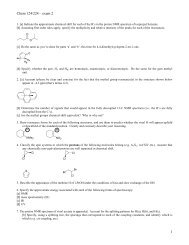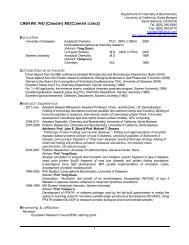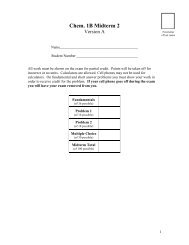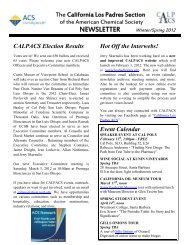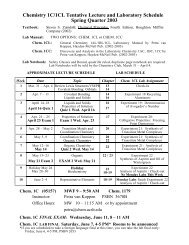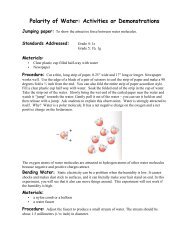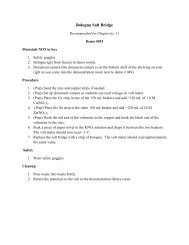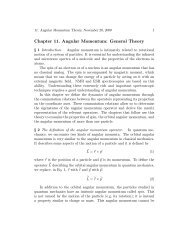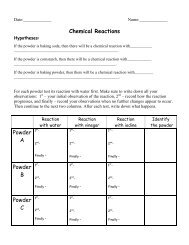Chapter 19
Chapter 19
Chapter 19
- No tags were found...
Create successful ePaper yourself
Turn your PDF publications into a flip-book with our unique Google optimized e-Paper software.
Homework #5<strong>Chapter</strong> <strong>19</strong>Transition Metals and Coordination Chemistry6. a) Ti = [Ar]4s 2 3d 2 Ti 2+ = [Ar]3d 2 Ti 4+ = [Ar]b) Re = [Xe]6s 2 4f 14 5d 5 Re 2+ = [Xe]4f 14 5d 5 Re 3+ = [Xe]4f 14 5d 4b) Ir = [Xe]6s 2 4f 14 5d 7 Ir 2+ = [Xe]4f 14 5d 7 Ir 3+ = [Xe]4f 14 5d 67. a) Cr = [Ar]4s 1 3d 5 Cr 2+ = [Ar]3d 4 Cr 3+ = [Ar]3d 3b) Cu = [Ar]4s 1 3d 10 Cu + = [Ar]3d 10 Cu 2+ = [Ar]3d 9c) V = [Ar]4s 2 3d 3 V 2+ = [Ar]3d 3 V 3+ = [Ar]3d 216. Coordination Compound: A compound composed of a complex ion and counter ionsufficient to give no net charge.Complex Ion: A charged species consisting of a metal ion surrounded by ligands.Counter Ion: Anions or cations that balance the charge on the complex ion in a coordinationcomplex.Coordination Number: The number of bonds formed between the metal ion and the ligands in acomplex ion.Ligand: A group attached to the central metal ion in a complex.Chelate: A complex containing at least one polydentate ligand that forms a ring of atomsincluding the central metal atom.Bidentate: A ligand that can form two bonds to a metal ion.22. a) hexaamminecobalt(II) chloride b) hexaquacobalt(III) iodidec) potassium tetrachloroplatinate(II) d) potassium hexachloroplatinate(II)e) pentaamminechlorocobalt(III) chloride f) triamminetrinitrocobalt(III)23. a) pentaamminechlororuthenium(III) ionb) hexacyanoferrate(II) ionc) tris(ethylenediamine)manganese(II) iond) pentaamminenitrocobalt(III) ion24. a) pentaaquabromochromium(III) bromideb) sodium hexacyanocobaltate(III)b) bis(ethylenediamine)dinitroiron(III) chlorided) tetraamminediiodoplatinum(IV) tetraiodoplatinate(II)Note: The oxidation numbers of platinum where determined by looking at the possibleoxidation numbers for platinum, these can be found in slide 7 of your class notes.Platinum is known to have oxidation numbers of +2,+4, +5, and +6 with +2 and +4 beingthe most common. If the platinum in the cation ([PtI 2 (NH 3 )] +x ) had a oxidation state of+2 then the overall charge of the ion would be 0. All of these compounds are ionicallybound together. In order for this to happen you need to have positive and negativespecies. Ionic bonds cannot form if there is not a transfer of electrons therefore, theoxidation state cannot be +2 on platinum in the cation. If the platinum in the cation([PtI 2 (NH 3 )] +x ) had a oxidation state of +4 then the overall charge of the ion would be +2.This would make the oxidation state of the platinum in the anion ([PtI 4 ] ‐y ) be +2 giving1
the total anion a charge of ‐2. Since +2 is alsoo a commonly observed oxidation numberfor platinum, this gives us the oxidation numbers of both the platinum atoms. Theoxidation number of the platinum in the cation is +4 and in the anion is +2. If you do themath for when the oxidation number of the cation +5 or +6 (other observed oxidationnumbers of platinum) you will see that you cannot get an oxidation state for theplatinum in the anion that is observed.25. a)K 2 [CoCl 4 ]c)Na 3 [Fe(CN) 2 (C 2 O 4 ) 2 ]26. a)[FeCl 4 ] ‐c)[Cr(OH) 2 (CO) 4 ] +b) [Pt(H 2 O)(CO) 3 ] Br 2d) [CrCl(NH 3 ) 3 (NH2 CH 2 CH 2 NH 2 )]I 2b) [Ru(NH 3 ) 5 (H 2 O)d) [PtCl 3 (NH 3 )] ‐)] 3+27. When the BaCl 2 is added tothe solution,no precipitate forms. Therefore, the sulfate ion mustbe bound to the cobalt because BaSO 4 isnot soluble and would have generated a precipitate ifnot bound to the metal.When AgNO 3 is added to the solution a precipitate does form. Therefore, Cl ‐ must be a counterion allowing AgCl 2 to form.SO2‐ 4 must be a bidentate ligand in order for the metal to have a coordinationnumber of 6.Therefore, thecompound must be [Co(SO 4 )(NH 3 ) 4 ]Cl31. a)Isomer: One of twoor more compounds thatt contain the same number of the sameatoms in different arrangements.Example:b) Structural Isomer:Example:Isomers in which the atoms have different partnersor lie in adifferent order. (Different chemical formulas)2
c) Stereoisomers: Isomers in which the atoms have the same partners but are indifferent arrangements in space. (Same chemical Formulas)Example:d) Coordination Isomers: Isomers that differ by the exchange of one of more ligandsbetween cationic complex and an anionic complex.Example:[CrBr(H 2 O) 5 ]Cl and [CrCl(H 2 O) 5 ]Bre) Linkage Isomers: Isomers that differ in the identity of the atom that a ligand usesto attach to a metal ion.Example:f) Geometric Isomers: Isomers in which atoms or groups of atoms can assumedifferent positions around a rigid bond.Example:g) Optical Isomers: Isomers in which one molecule is the mirror image of the othermolecule.Example:32. a) 2 bonds, one to each of the lone pair of electrons on the oxygen atomsb) 3 bonds, one to each of the lone pair of electrons on the nitrogen atomsc) 4 bonds, one to each of the lone pair of electrons on the oxygen or the nitrogen atomsd) 4 bonds, one to each of the lone pair of electrons on the nitrogen atoms3
33. a)b)c)d)Note:is an abbreviation for ethylenediamine (NH 2 CH 2 CH 2 NH 2 )34. a)b)c)d)4
e)37.M is a transition metal ion39. Linkage Isomer: Isomers that differ in the identity of the atom that a ligand uses toattach to a metal ion.Inorder to form a linkage isomer there needs to be at least 2 different types of atoms in theligand and there needs to be lone pairs on the different types of atoms.Capable of forming linkage IsomersSCN ‐ (loan pair on both S and N)NO ‐ 2 (loan pair on both O and N)OCN ‐ ( loan pair on both O and N)Not Capable of forming linkage IsomersN ‐ 3 (only one type of atom)NH 2 CH2 CH 2 NH 2 (only the nitrogen atoms have lone pairs, therefore only 1 bonding site)I ‐ (onlyone type of atom)40.5
42.There are 5 geometrical isomers (ligandsare attachedd to differentt locations (different chemicalnames)) (i‐v)Note v. (cis‐diaquadibromodicyanoplatinum(VI)) and its mirror image are bothoptical isomers (isomers that have the same neighbors but have different locations relative toeach other andare not identical to theirmirror imagee (yet they have the samechemicalformulas)).45. Weak‐Field Ligand: A ligandthat produces a small ligand field splitting (lies below NH 3in spectochemicalseries).Strong Field Ligand: A ligand that produces a large ligand field splitting (lies above H 2 Oin the spectochemical series).Low‐Spin Complex: A transition metal complex with the minimumm number of unpairedelectrons.High‐Spin Complex: A transition metal complex with the maximumm number of unpairedelectrons.46. Cu = [Ar]4s 1 3d10 (lower energy when 3d orbital is full) )Cu 2+ = [Ar]3d 9Cu + = [Ar]3d 10Complex appear colored because electrons are able to transition between the split d orbitals.Since Cu + has a full d shell, no electrons can transition, therefore, Cu + compounds tend to becolorless. Cu 2+has space for an electronto be promoted, therefore, Cu 2+ compounds areexpected to becolored.Cd(NH 3 ) 4 Cl 2 Cd2+ = [Kr]4d 10Since Cd 2+ has a filled d orbital, compounds formed from Cd 2+ would not be expected to havecolor.50. Order of increasing energy absorbed hc E 770 nm< 440 nm < 290 nmOrder of increasing ligand field strengthF ‐ < NH3 < CN ‐The stronger the field ligand, the greater the ligand field splitting.Order of increasing ligand field splitting3‐3+ 3‐CoF 6 < Co(NH 3 ) 6 < Co(CN) 63‐CoF 6 770 nm6
3+Co(NH 3 ) 63‐Co(CN) 6440 nm290 nm51. a) Fe 2+ = [Ar]3d 6 b) Fe 3+ = [Ar]3d 5Low SpinHigh Spin d 2 d 2 2d dz x yz x yd d2 2 2z x y2 2 2 d d dxy xz yz d d dxy xz yzc) Ni 2+ = [Ar]3d 8 d) Zn 2+ = [Ar]3d 10 d d dxy xz yzdd2 2 2z x ydd2 2 2z x y d d dxy xz yze) Co 2+ = [Ar]3d 7Low Spind d2 2 2z x y d d dxy xz yzHigh Spindd2 2 2z x y d d dxy xz yz d d dxy xz yz52.3+Co(NH 3 ) 6 , therefore, Co 3+ Fe(H 2 O) 2+ 6 , therefore, Fe 2+Co 3+ = [Ar]3d 6 (Low Spin)Fe 2+ = [Ar]3d 6 (High Spin)dd2 2 2z x ydd2 2 2z x y d d dxy xz yz d d dxy xz yzNo unpaired electrons (diamagnetic) Four unpaired electrons (paramagnetic)NH 3 is a strong field ligand, therefore, it will form a low spin complex. Causing Co(NH 3 ) 3+ 6 tohave no unpaired electrons and be diamagnetic. H 2 O is a weak field ligand; therefore, it will7
form a high spin complex. Causing Fe(H 2 O) 6 2+ to have four unpaired electrons and beparamagnetic.53. a) Ru(NH 3 ) 2+ 6 , therefore, Ru 2+ b) Ni(H 2 O) 2+ 6 , therefore, Ni 2+Ru 2+ = [Kr]4d 6 (Low Spin)Ni 2+ = [Ar]3d 8 (Low Spin) d dd d2 2 2z x y2 2 2z x y d d dxy xz yzNo unpaired electronsc) V(en) 3+ 3 , therefore, V 3+V 3+ = [Ar]3d 2 (Low Spin) d d dxy xz yz2 unpaired electronsdd2 2 2z x y d d dxy xz yz2 unpaired electrons56. Fe(CN) 6 3‐ , therefore, the metal ion is Fe 3+Fe 3+ = [Ar]3d 5If there is only one unpaired electron the complex must be low spin, as seen below.dd2 2 2z x y d d dxy xz yz8
Fe(SCN) 3+ 6 , therefore, Fe 3+Fe 3+ = [Ar]3d 5In order to have 5 unpaired electrons the complex must be high spin, as seen below. d d2 2 2z x y d d dxy xz yzTherefore, SNC ‐ must be a weaker field ligand than CN ‐ causing it to lie below CN ‐ on thespectrochemical series.57. Test Tube #1: Appears: Violet Absorbs: YellowTest Tube #2: Appears: Yellow Absorbs: VioletTest Tube #3: Appears: Green Absorbs: RedOrder of increasing ligand field strengthCl ‐ < H 2 O < NH 3The stronger the field ligand, the greater the ligand field splitting.Order of increasing ligand field splittingCr(H 2 O) 4 Cl + 2 < Cr(H 2 O) 3+ 3+6 < Cr(NH 3 ) 6Order of increasing wavelength absorbedtest tube #2
Calculate the moles of NH 3 in A (use date ii)0.100mol1 mol NH3 1 L HCl 1 mol HCl 0.0329 L HCl 0.00329 mol NHCalculate the mass percent of NH 30.00329 mol NH 0.0560 mol NH317.04g3 1 mol NH3 m 0.0560gNH3 NH3mTotal0.341g3mass % NH = 100% 100% 16.4% Calculate the moles of NH 3 in 100 g of A16.4 g NH 0.962 mol NH1 mol NH33 17.04 g3Calculate x0.962molx 4.96 50.<strong>19</strong>4molCalculate yxy 6y 6x651Calculate z3 1 y 1z z 3 y 312[CrI(NH 3 ) 5 ]I 2310




